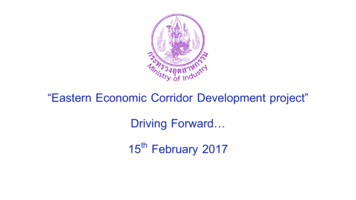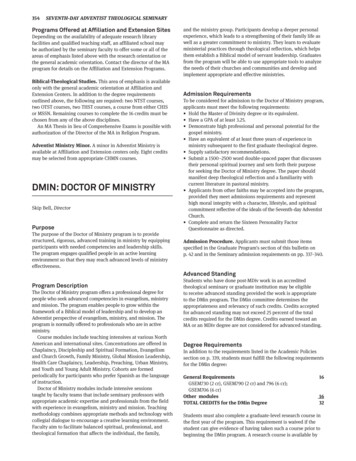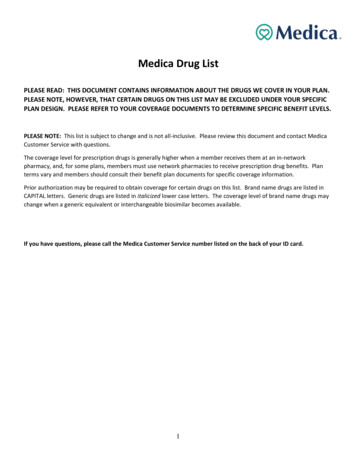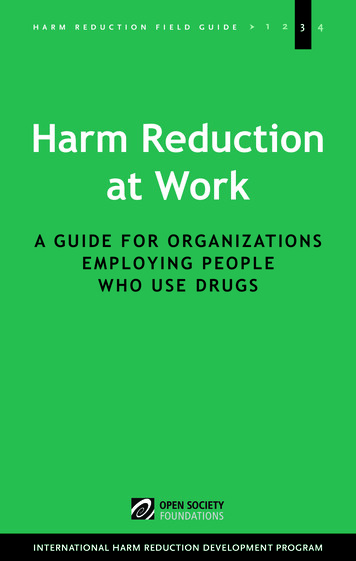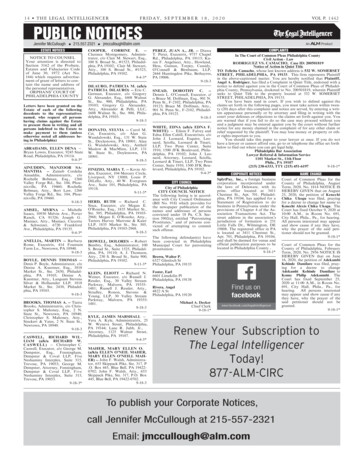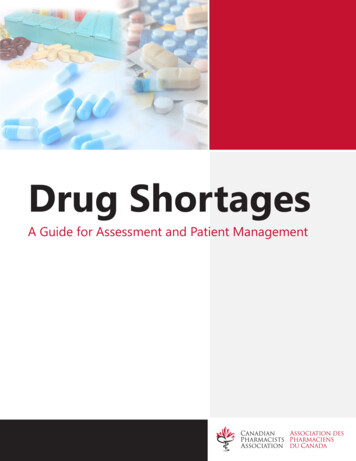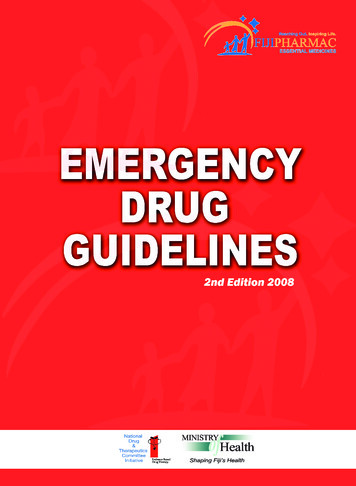
Transcription
Emergency DrugGuidelinesSecond Edition2008Ministry of HealthGovernment of Fiji Islands2008"This document has been produced with the financial assistance of theEuropean Community and World Health Organization. The viewsexpressed herein are those of the Fiji National Medicine & TherapeuticsCommittee and can therefore in no way be taken to reflect the officialopinion of the European Community and the World Health Organization.”
DisclaimerThe authors do not warrant the accuracy of the information contained inthis 2ndEdition of the Emergency Drug Guidelines and do no takeresponsibility for any death, loss, damage or injury caused by using theinformation in these guidelines.While every effort has been made to ensure that these guidelines arecorrect and in accordance with current evidence-based and clinicalpractices, the dynamic nature of medicine information requires thatusers exercise in all cases independent professional judgment andunderstand the individual clinical scenario when referring, prescribing orndproviding information from the Emergency Drug Guidelines, 2 Edition.
PrefaceThe publication of the Second Edition of the Emergency DrugGuidelines represents the culmination of the efforts of the NationalDrugs and Therapeutics Committee (NDTC) to publish clinical drugguidelines for common diseases seen in Fiji.These guidelines aretargeted for health care professionals working at hospitals and at theprimary health care settings. It sets the gold standard for the use ofdrugs in the treatment of emergency medical conditions in Fiji.The guidelines have taken into account the drugs available in the FijiEssential Medicines Formulary (EMF), 2006 Edition, in recommendingtreatment approaches. All recommended therapies are either evidencebased or universally accepted standards.It is hoped that these guidelines will be used by all health care workersin their daily care of patients suffering from emergency medicalconditions.DR. MARGARET CORNELIUSChairpersonNational Drugs and Therapeutics CommitteeMinistry of Health, Suva, Fiji2008
AcknowledgementsThe First Edition of these guidelines was drafted on behalf of theMinistry of Health (MOH) by Nick Adams, MBBS (Melb), FACEM,Principal Medical Officer, Accidents and Emergency Department,Colonial War Memorial Hospital in 1999.The Ministry of Health initially approached Dr Adams to prepare theseguidelines as part of an overall effort to develop treatment guidelines incritical areas. Dr Adams prepared these guidelines during hisemployment as a specialist emergency physician at CWM Hospital. TheMinistry of Health gratefully acknowledges the personal enthusiasm andinitiative of Dr Adams in producing these guidelines.Dr Adams was assisted by Elizabeth Pemberton, MBBS, FANZCA,Long-Term Advisor in Anaesthesia, Pacific Postgraduate MedicalCentre, Fiji School of Medicine, in the preparation of the draftguidelines.The guidelines have been reviewed by a subcommittee of the NationalDrugs and Therapeutics Committee.Subcommittee on the Preparation of the Second Edition of theEmergency Drug GuidelinesDr Gyaneshwar RaoConsultant Physician, Colonial War Memorial HospitalProf Robert MouldsClinical Pharmacologist, Professor of Medicine, Fiji School of Medicine
Dr Alan Mamerto GarvezConsultant Physician, Colonial War Memorial HospitalDr.Adam JenneySpecialist Physician, Colonial War Memorial HospitalDr Anne DrakeSenior Lecturer in Medicine, Fiji School of MedicineMs Vasiti Nawadra-TaylorPrincipal Pharmacist, Fiji Pharmaceutical Services
Table of Contents12Emergency Drugs11.1Local anaesthetics11.2Sedatives and induction agents11.3Anticholinergics21.4Opiod es51.10Inotropic agents51.11Diuretics61.12Muscle relaxants61.13Neuroleptics61.14Anti-asthma drugs71.15Intravenous fluids71.16Tetanus prophylaxis81.17Drugs used in cardiac arrest8Cardiovascular Emergencies102.1Cardiac arrest102.2Cardiogenic shock152.3Unstable angina162.4Acute myocardial infarction172.5Cardiac arrhythmias192.6Acute pulmonary oedema242.7Hypertensive emergency26
3456Respiratory Emergencies273.1Asthma273.2Exacerbation of chronic obstructivepulmonary disease293.3Croup303.4Epiglottitis313.5Oxygen therapy32Neurologic ic crisis364.4Tetanus364.5Acute bacterial meningitis in adults37Poisoning and Overdoses385.1General principles395.2Treatment of specific poisons405.3Poisons information47Endocrine Emergencies486.1Diabetic ketoacidosis486.2Hyperosmolar, hyperglycaemic state506.3Adrenal insufficiency506.4Hypoglycaemia516.5Thyroid storm6.6Myxydema coma52(hypothyroid crisis)52
6.778AppendixPhaeochromocytoma53Fluid and Electrolyte 3Hypercalcaemia557.4Hypocalcaemia567.5Fluid resuscitation56Miscellaneous Septic shock618.4Acute psychosis6263
1Emergency DrugsThis section is intended as a brief guide to some of the drugsmentioned in this book. It is by no means exhaustive and doesnot cover all contraindications or dosage alterations in specialsituations. Information about these areas should be obtainedelsewhere. The dosages below are guides only. Drug therapyshould always be adjusted to the individual patient situation.1.1Local AnaestheticsLocal anaesthetic agents are used to provide anaesthesiathrough local wound infiltration, nerve blocks or regionaltechniques. Side effects from systemic absorption includeseizures and cardiac arrhythmias. Avoid accidental intravenousadministration by aspirating for blood prior to injection.Lignocaine is the agent of choice for local wound infiltration.The 1% solution is suitable for local infiltration of mostwounds. A concentration of 2% should be used for digitalnerve blocks and any other area where a smaller volume ofanaesthetic is desirable.Lignocaine with adrenaline should not be used on theextremities, i.e. nose, fingers, toes, ears or penis. The additionof adrenaline helps control bleeding and also extends theduration of anaesthesia.1
1.2Sedatives and Induction AgentsThese drugs are used to depress the conscious state either forsedation or general anaesthesia. They should be used withgreat care as unconscious patients are unable to protect theirairway and because of the risk of causing hypoventilation andhypotension.Ketamine has anaesthetic and analgesic properties and is lesslikely to produce hypotension than other sedative agents. Italso has a mild bronchodilator action which makes it usefulwhen anaesthetising patients with asthma. Adverse effectsinclude increased salivation, laryngospasm, raised intracranialpressure and unpleasant hallucinations after recovery ofconsciousness. Ketamine should not be used in patients at riskof raised intracranial pressure (e.g. head injuries, meningitis) orin patients with ischaemic heart disease. It should not be givenunless personnel and facilities are available to protect thepatient’s airway.Ketamine should be given as an intravenous bolus. The usualdose is 2 mg per kg although some patients may require largeramounts. The onset of action is within 60 seconds and theduration is about 20 minutes.Thiopentone is a barbiturate with a short action because ofrapid distribution.Its main adverse effects relate tocardiorespiratory depression. It should be used with great carein patients who are hypotensive and should not be given unlesspersonnel and facilities are available to protect the patient’s2
airway. It is a potent anticonvulsant and is the drug of choicefor anaesthetising patients with status epilepticus.Thiopentone should be given as an intravenous bolus. Theusual dose is 3 to 5 mg per kg. The lower dose should be usedin the elderly. The onset of action is about 30 seconds and itseffects last for 5 to 10 minutes.Midazolam is a short-acting benzodiazepine. It has powerfulamnestic properties and produces less cardiorespiratorydepression than thiopentone. It is a fairly safe and usefulanaesthetic induction agent in the critically ill and is also usedto sedate children and agitated patients.Midazolam can be given intramuscularly or as an intravenousbolus.In children, intranasal midazolam is a usefulpremedication prior to suturing. The onset of action ofintravenous midazolam is 1 to 2 minutes and the effects of asingle dose last from 60 to 90 minutes. Intranasal midazolamhas its maximal effect within 10 minutes and lasts up to 2hours.In ADULTS: The intravenous dose is 2.5 to 15 mg. The doseshould be titrated to its effect. Smaller doses are usuallyrequired for the elderly, whereas alcoholics may require higherdoses. The intramuscular dose is 5 to 10 mg.In CHILDREN: The intravenous dose is 0.15 to 0.3 mg per kgup to 0.5 mg per kg. The intranasal dose is 0.2 to 0.4 mg per kg(to a maximum of 5 mg), slowly dropped into alternate nostrils3
over 15 seconds.1.3AnticholinergicsAnticholinergic drugs block the effects of acetylcholine atmuscarinic receptors.The most commonly usedanticholinergic agent is atropine. This drug is used for thetreatment of bradycardia due to increased vagal tone, to blockthe cholinergic effects of drugs such as suxamethonium inchildren, and to reverse some of the adverse effects ofanticholinesterase (organophosphate) poisoning. Ipratropiumis used in the treatment of asthma and benztropine is used inthe treatment of oculogyric crisis.Atropine should be used with care in patients with ischaemicheart disease as it may cause a marked sinus tachycardia. Theusual adult dose is 0.6 mg intravenously as a bolus, repeated in5 minutes if necessary. A dose of 3 mg will produce completeblockade of muscarinic cholinergic receptors in an adult.Much larger doses are used in anticholinesterase poisoning.Atropine may be given via the endotracheal tube in anemergency; use twice the normal intravenous dose and dilute in10 ml of 0.9% saline. The paediatric dose is 20 microgramsper kg (to a maximum of 0.5 mg). The onset of action is within5 minutes and the duration of action is 2 to 4 hours.Benztropine is used in the treatment of oculogyric crisisprecipitated by prochlorperazine or similar drugs. Overdose of4
benztropine can cause central anticholinergic syndrome(confusion, hallucinations). The usual dose in adults is 1 to 2mg orally or intramuscularly. Children should be given 20micrograms per kg. Its duration of action is shorter than mostof the drugs that cause oculogyric crisis so a repeat oral doseshould be given 4 hours after the initial dose.1.4Opioid AnalgesicsOpioid agents are mainly used for their analgesic and sedativeactions. The main side effects of these drugs are respiratorydepression, hypotension, nausea, vomiting, and constipation.NOTE: The use of parenteral opioid drugs is not recommendedin patients with chronic or recurrent painful conditions such asmigraine or back pain due to the risk of addiction.Morphine is usually used in the treatment of acute myocardialinfarction and pulmonary oedema. As an analgesic, it mayproduce less dysphoria than pethidine. The usual dose in adultsis 2.5 mg intravenous bolus repeated every few minutes asrequired to a maximum of 15 mg. The usual dose in children is0.05 mg per kg given intravenously every 5 minutes to amaximum of 0.2 mg per kg. The duration of action is about 3hours.Pethidine is mainly used as an analgesic. This is a highlyaddictive drug even after a few doses. The best method ofadministration is a dose of 25 to 50 mg intravenously every 3 to4 hours. Alternatively, a dose of 25 to 100 mg (maximum 1505
mg) may be given intramuscularly. The duration of action is 2to 3 hours with intramuscular dose and shorter with intravenousadministration.Fentanyl is a short acting narcotic used to sedate patients priorto painful procedures or intubation (often in combination withmidazolam). The usual dose of fentanyl is 1 microgram perkg. The duration of action is 30 to 40 minutes.1.5AntiemeticsAnti-emetic drugs are used for the temporary relief of nauseaand vomiting.Metoclopramide (brand name: Maxolon) should not be givento children less than 16 years of age due to the high incidenceof acute dystonic reactions. It should also not be given topatients with bowel obstruction. Metoclopramide is useful inthe treatment of migraine and may also help the passage ofcalculi in renal colic. The usual dose is 10 mg by intravenousbolus or intramuscular injection or orally. Males weighingmore than 70 kg may require 15 or 20 mg. Females with lowbody weight or the elderly should be given 5 mg initially.Prochlorperazine (brand name: Stemetil) is also useful for thetreatment of vertigo as well as nausea and vomiting. It shouldnot be given to children less than 16 years of age. The oraldose is 5 to 10 mg 8-hourly. The intramuscular or intravenousdose is 12.5 mg every 8 hours.6
Promethazine (brand name:Phenergan) is a weakerantiemetic than prochlorperazine and is more sedating. It canbe given intravenously, intramuscularly or orally. The usualdose is 0.5 mg per kg.1.6CorticosteroidsAlthough very useful in the treatment of asthma, anaphylaxisand many other conditions, the beneficial effects of these drugsare delayed for several hours at least. They should be usedwith care in patients with diabetes or peptic ulcer disease. Allagents have similar anti-inflammatory effects but differ in theirmineralocorticoid potency.Their mineralocorticoid (oraldosterone-like) effects may be undesirable and includesodium retention, oedema, and hypokalaemia.Equivalent anti-inflammatory doses are:100 mg hydrocortisone 25 mg prednisolone 4 mgdexamethasoneHydrocortisone has marked mineralocorticoid effects. Itshould be given intravenously over 5 minutes. The usual doseis 50 to 100 mg intravenously 6-hourly.Dexamethasone has virtually no mineralocorticoid effects. Itcan be given intramuscularly or intravenously as well as orally.The usual dose is 0.1 mg per kg every 8 hours.Prednisolone has moderate mineralocorticoid effects.7It is
given orally. The usual dose is 1 mg per kg daily to amaximum of 80 mg.1.7AntiepilepticsThe first line drug in the treatment of epilepsy is diazepam.Phenytoin is useful for the treatment of idiopathic epilepsy butis less effective for seizures due to other causes. Barbituratessuch as phenobarbitone are powerful anti-epileptics but alsocause cardiorespiratory depression and marked depression ofconscious state often necessitating intubation and ventilation.Diazepam is a safe and effective agent for the termination ofseizures. It may be given intravenously or rectally. The oralroute is too slow in an emergency, whereas the intramuscularroute is painful and unpredictable. The onset of action whengiven intravenously is 1 to 2 minutes, whereas the rectal routemay take 5 to 10 minutes to have its full effect. The usualintravenous dose is 0.1 mg per kg repeated every 5 minutes ifrequired. The usual rectal dose is 0.5 mg per kg.Phenytoin must be given by slow intravenous injection. Theinfusion rate should not exceed 50 mg per minute in adults or 1mg per kg per minute in children. The drug should be dilutedin 0.9% saline only (not 5% dextrose) so that the concentrationis no greater than 5 mg per ml. Rapid infusion of concentratedsolutions may cause hypotension. The usual loading dose is15 mg per kg intravenously.8
1.8Antiarrhythmics1.8.1LignocaineLignocaine shortens the action potential duration. It is the drugof first choice in the treatment of ventricular tachycardiaalthough phenytoin is used in the treatment of ventriculartachycardia due to digoxin toxicity.Lignocaine 2% should be given intravenously over one minutein a dose of 1 mg per kg. A further 0.5 mg per kg may begiven after 5 minutes if necessary. Lignocaine has a very shorthalf-life so the intravenous bolus should be followed by aninfusion at a rate of 40 micrograms per kg per minute. Adverseeffects include confusion, coma, seizures and heart block butare not often encountered. Elderly patients may require lowerinfusion rates.1.8.2PropranololPropranolol is occasionally used to delay conduction throughthe atrioventricular (AV) node in the treatment ofsupraventricular tachycardia or atrial fibrillation. It also maybe of benefit in the treatment of ventricular tachycardia due totheophylline overdose. Propranolol should not be used inpatients with decompensated left ventricular failure, asthma, orbradyarrhythmias. The dose should be titrated according toeffect. Give 10 micrograms per kg intravenously every 2minutes to a maximum of 100 micrograms per kg.9
1.8.3AmiodaroneAmiodarone prolongs the action potential duration. It is usedin the treatment of both ventricular and atrial arrhythmias. Atleast some of its therapeutic effects are often delayed for up to24 hours. Amiodarone is not a negative inotrope and is welltolerated by patients with cardiac failure.Intravenousadministration is occasionally associated with hypotension dueto vasodilation. The usual loading dose of amiodarone is 5 mgper kg given intravenously over 30 minutes.1.8.4VerapamilVerapamil is a calcium channel antagonist and depresses sinusnode automaticity and AV node conduction. It is thereforeused to treat supraventricular tachyarrhythmia. It is a powerfulnegative inotrope and should be used with great care in patientswith impaired left ventricular function.Verapamil should not be given to children less than 2 years ofage. It should not be given to patients with left ventricularfailure, bradycardia, or hypotension. The effectiveness ofvagal manoeuvres is increased following the administration ofverapamil.The usual dose in adults is 1 mg intravenousboluses every minute to a maximum of 10 mg.1.8.5DigoxinDigoxin is used to control the ventricular rate in atrialfibrillation. It is contraindicated in atrial fibrillation associated10
with Wolff-Parkinson-White syndrome. The main advantagedigoxin has over other drugs available to control conductionthrough the AV node, is the fact that it is not a negativeinotrope. Most patients with atrial fibrillation have significantunderlying cardiac disease and often tolerate poorly themyocardial depressant effects of verapamil and propranolol,making digoxin the safest choice. The effects of digoxin areincreased in the presence of hypokalaemia, hypothyroidism,hypomagnesaemia, and hypercalcaemia. Digoxin should notbe given to patients with bradycardia.The maximumtherapeutic effects of digoxin are delayed by 6 to 24 hours afteradministration. The usual initial dose is 10 micrograms per kggiven intravenously over 20 to 30 minutes and the totaldigitalizing dose should be given within 24 hours.1.8.6AdenosineAdenosine is a very short acting agent used in the treatment ofsupraventricular tachycardia. It is best given in incrementaldoses according to response (usually 6 mg initially and if noresponse, give 12 mg and if necessary followed by 18 mg).Adenosine should be given as a rapid intravenous bolusfollowed by a 20 ml 0.9% saline flush. It should be given withgreat care to asthmatics as it may occasionally induce severebronchospasm in these patients. Adenosine is antagonised bytheophylline and is unlikely to be effective in patients who aretaking this drug.11
1.9AntihypertensivesSeveral different drugs are available for the management ofhypertensive emergencies.Hydrallazine is a direct acting arteriodilator. It should not beused in patients with ischaemic heart disease who are not beingtreated with a beta-blocker. Side effects include nausea,tachycardia, and headache. Peak effects are not seen for 10 to20 minutes after intravenous injection and it has a duration ofaction of 4 to 8 hours. The usual dose in adults is 10 mgintravenously every 20 minutes to a maximum of 50 mg.Nifedipine is a direct-acting arterial vasodilator. When givenby sublingual route, it has unpredictable effects and canprecipitate myocardial infarction or stroke by excessivelowering of blood pressure. Hence, it should not given by thisroute.1.10Inotropic AgentsInotropic agents are used in the treatment of cardiogenic anddistributive shock. All should be infused via a large vein.Adrenaline is an alpha- and beta-adrenergic agonist. It causesan increase in cardiac output and heart rate plusvasoconstriction. It is given by infusion into a large vein at arate of 1 to 70 micrograms per minute titrated to effect.12
Dopamine has similar effects to adrenaline but produces moretachycardia at higher doses. It may preferentially enhance renalblood flow at rates less than 5 micrograms per kg per minute.Dobutamine has positive chronotropic and inotropic effectswhich are balanced by a mild degree of vasodilation so thatmyocardial oxygen demand is generally not increased.Dobutamine is generally considered the inotrope of choice inpatients with myocardial ischaemia. The usual dose range is 2to 20 micrograms per kg per minute titrated to effect.1.11DiureticsFrusemide is a potent loop diuretic used in the treatment offluid overload. Its main side effects are hypokalaemia andfluid depletion. Damage to the inner ear may occur with toorapid intravenous injection. Frusemide is ineffective in theacute treatment of hypertension and should not be used exceptas an adjunct to other more powerful drugs.Intravenous frusemide has an onset of action within 5 minutes,a peak effect at about 30 minutes, and a duration of action of 2hours. Dosage varies according to renal function; most patientswithout renal impairment will have a significant diuresis after40 mg given intravenously. Doses in excess of 250 mg may berequired to diurese patients with severe renal failure.Frusemide should not be given intravenously at a rate fasterthan 40 mg per minute. The absorption of intramuscularfrusemide is unpredictable and this route of administration13
should not be used.1.12Muscle RelaxantsSuxamethonium is a depolarising muscle relaxant. It is givenas an intravenous bolus and has its maximal effect within 60seconds. The duration of paralysis is usually about 5 minutes.Very rarely, some patients with an atypical plasmacholinesterase enzyme will be paralysed for much longer. Theusual dose is 1 to 1.5 mg per kg in adults and 2 mg per kg inchildren. Suxamethonium is contraindicated in the presence ofhyperkalaemia, lower motor neurone diseases, and between 3days and 2 years after major burns. In the absence of thesecontraindications, suxamethonium is the drug of first choice formuscle relaxation in rapid sequence intubation.Vecuronium is a non-depolarising muscle relaxant. Given asan intravenous bolus it has its onset in about 3 minutes andlasts 20 to 30 minutes. The usual dose is 0.1 mg per kg.1.13NeurolepticsHaloperidol is the safest neuroleptic to use for sedation. Itmay be given intramuscularly or intravenously. The usualintravenous dose in adults is 2.5 mg repeated every 5 minutesto a maximum of to 10 mg.Chlorpromazine is more likely to cause hypotension thanhaloperidol.14
Diazepam can be used as a sedative for short defined periodsof treatment to avoid addiction.1.14Anti-asthma DrugsSalbutamol is a beta-2 adrenergic agonist. It is best given inthe inhaled form (either via an inhaler or a nebulizer).Intravenous salbutamol may occasionally be required for verysevere asthma where marked airway obstruction may preventthe inhaled form of the drug from reaching the distal airways.The main side effects of salbutamol are sinus tachycardia,tremor, and anxiety. It can also cause hypokalaemia.Nebulized salbutamol may be given as often as necessary, evencontinuously. The upper dose limit is defined in each patientby the adverse effects of tachyardia and tremor. The usual doseis 5 mg in adults and older children, and 2.5 mg in children lessthan 5 years old. The dose should be diluted up to 2 ml using0.9% saline but may be given without dilution.Intravenous salbutamol is given in a dose of 5 micrograms perkg (up to a maximum of 250 micrograms) over 1 to 2 minutesand repeated once 15 minutes later if necessary.Ipratropium is used in the treatment of asthma and chronicobstructive pulmonary disease (COPD). It has a synergisticeffect with salbutamol. Adverse systemic effects are very rarebut nebulized ipratropium can inadvertently enters the eye andcauses a fixed, dilated pupil. The usual dose in adults is 0.5 mg15
via a nebulizer every 4 to 6 hours. Children 5 years of age orunder should be given 0.25 mg per dose.Corticosteroids are discussed in Section 1.6.Aminophylline is a xanthine derivative that has been used formany years in the treatment of asthma. However, it is a weakbronchodilator and has no additional benefit over optimal dosesof salbutamol. It also has a very narrow therapeutic marginand therefore has little place in the management of acuteasthma. Adverse effects include ventricular tachycardia,seizures, and hypokalaemia. Its use should be restricted tosevere asthma.1.15Intravenous FluidsNormal (0.9%) saline contains 154 mmol per liter of sodiumchloride. It is essentially isotonic and iso-osmolar, and isdistributed to the extracellular fluid space. It is the fluid offirst choice in the treatment of hypovolaemia. Normal salinecontains too much saline to be used as the sole maintenancefluid, although it may be alternated with 5% dextrose.Dextrose 5% contains 50 g per liter of dextrose.It isdistributed to the total body water space and is thus not suitablefor emergency rehydration. Although it can be used as thesole maintenance fluid in the short term, prolongedadministration of 5% dextrose alone may cause hyponatraemia,especially in children.16
Dextrose 3% with 0.3 saline contains 51 mmol per liter ofsodium chloride and 30 g per liter of dextrose. Its primary useis as a maintenance fluid (with potassium) in children. It maybe suitable for rehydration of patients with mild or moderatedehydration.Hartmann’s solution contains a mixture of ions similar to thatof the extracellular fluid. It may be substituted for 0.9% salineexcept in the presence of hyperkalaemia or alkalosis. Itcontains 140 mmol per liter of sodium, 109 mmol per liter ofchloride, 29 mmol per liter of bicarbonate, 5 mmol per liter ofpotassium, and 2 mmol per liter of calcium.Plasma volume expanding solution (e.g. Haemaccel,Gelofusin):Colloids can be used for patients withhypovolaemic shock in association with crystalloid solutions.1.16Tetanus ProphylaxisRegular immunization with tetanus toxoid is the best way toprevent death due to tetanus. Children should receive doses oftetanus toxoid at 6, 10 and 14 weeks of age then booster dosesat 6 years. Thereafter, booster doses of tetanus toxoid shouldbe given every 10 years.Patients presenting with a skin wound should be treated asdescribed below. A non-immune patient is one who has neverreceived a full course of tetanus toxoid injections. Tetanus17
prone wounds include puncture wounds, contaminated orinfected wounds and crush wounds.1.16.1 Non-immunewoundpatientwithtetanusprone Give tetanus toxoid 0.5 ml intramuscularly and completecourse (with repeat tetanus toxoid injections at 6 weeksand 6 months),PLUS Give tetanus immune globulin 250 units intramuscularly ata different site than that of the tetanus toxoid injection.1.16.2 Non-immune patient with clean wound Give tetanus toxoid 0.5 ml intramuscularly and completecourse (with repeat tetanus toxoid injections at 6 weeksand 6 months).1.16.3 Immune patient with tetanus prone woundIf more than 5 years since last tetanus toxoid booster THEN Give tetanus toxoid 0.5 ml intramuscularly.1.16.4 Immune patient with clean woundIf more than 10 years since last tetanus toxoid booster THEN18
Give tetanus toxoid 0.5 ml intramuscularly.1.17Drugs Used in Cardiac ArrestAdrenaline is a powerful endogenous catecholamine. Thepharmacologic doses used in cardiac arrests far exceed theamounts usually produced by the adrenal glands. Adrenalinehas both alpha- and beta-adrenergic agonist effects. Itstimulates myocardial contraction, increases the heart rate, andraises the blood pressure. Its most dangerous adverse effect isinduction of ventricular arrhythmias, an effect which is farmore likely when the myocardium is sensitized tocatecholamines. This occurs with myocardial ischaemia(which adrenaline can also induce by increasing myocardialwork), and with overdoses of drugs such as amphetamines andcocaine. In the setting of a cardiac arrest, the induction ofventricular arrhythmias is obviously not a problem and a largeintravenous bolus doses should be given.However, insituations other than cardiac arrest, such as anaphylaxis orasthma, adrenaline should be used with great care to avoidworsening the patient’s condition. In these circumstances,adrenaline is best given intravenously in small carefully titrateddoses. Also see Section 1.10.The absorption of adrenaline given by the subcutaneous orintramuscular routes is unpredictable especially in shock statesbut administration by these routes can be life-saving in patientsin shock states due to anaphylaxis. In ventricular fibrillation orasystole, adrenaline should be given in doses of 1 mg by19
intravenous bolus. Administration should be by a central line ifalready present or by a large peripheral vein and followed by a20 ml 0.9% saline flush to ensure it rapidly reaches the centralcirculation. If there is no intravenous access then adrenalinecan be given via the endotracheal tube. When given by thisroute it should be diluted in 10 ml of 0.9% saline and the doseshould be 5 times the intravenous dose. There is no role forintracardiac injection of adrenaline (or any other drug).Lignocaine is recommended for the treatment of ventricularfibrillation and ventricular tachycardia. Its effectiveness has notbeen proven but it is unlikely to be harmful. The usual dose is1 mg per kg intravenously given over 1 minute. Lignocainehas a short therapeutic half-life so a successful bolus doseshould be followed by a lignocaine infusion. Lignocaine maybe given vi
this 2nd Edition of the Emergency Drug Guidelines and do no take responsibility for any death, loss, damage or injury caused by using the information in these guidelines. While every effort has been made to ensure that these guidelines are correct and in accordance with current evidence-based and clinical

